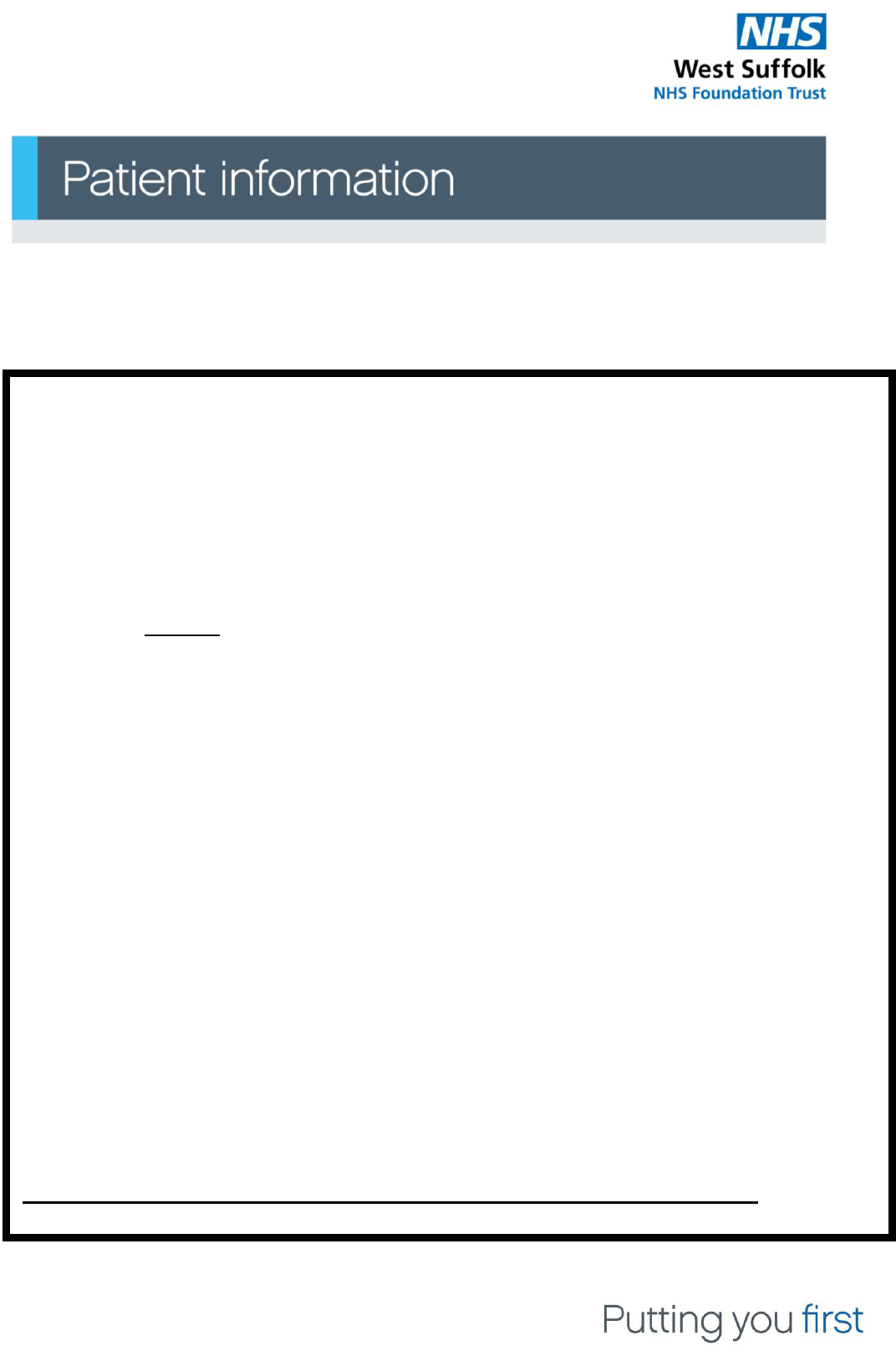
Source: Lymphoedema services
Reference No: 6669-1
Issue date: 8/10/20
Review date: 8/20/23
Page 1 of 9
How to do self-lymphatic massage on
your head and neck
What to avoid
• Do not strain your shoulders, neck, arm or hand
• Do not self-massage in a way that causes pain
• Do not continue self-massage if it is causing you pain
• Do not self-massage if you have an infection in that area
Important: Do not do self-massage if you have an infection in your head or neck.
Signs of infection may include:
• Swelling in these areas and redness of the skin (this redness can quickly
spread)
• Feeling pain in the head and/or neck
• Feeling tenderness and/or warmth in the head/neck
• Having a fever or chills and feeling unwell
If you have an infection or think you have an infection, go to:
• Your GP
• Walk in centre
• Urgent care clinic
• Emergency department
• NHS 111 out of hours service
You will require x2 weeks of double strength antibiotics, as per the British
Lymphology Society guidelines, available at:
https://www.lymphoedema.org/images/pdf/cellulitisconsensus.pdf

2
Page 2 of 9
What is the lymphatic system?
Your lymphatic system removes fluid build-up and
waste from your body and plays an important role in
your immune function. It is made up of lymph nodes
that are connected by lymph vessels.
Large groups or chains of lymph nodes can be found in
your neck, under your arms and in your groin (see
picture to the right).
How does self-massage help with
lymphoedema?
Self-lymph drainage, or SLD, is a special type of gentle
massage that helps move extra fluid from an area that
is swollen (or is at risk of becoming swollen), into an
area where the lymph nodes are working properly.
This is done by stimulating contractions of lymphatic
vessels.
The anatomy of the lymphatic system in the head and neck
Occipital lymph
nodes
Parotid lymph nodes
Submental lymph nodes
Submandibular lymph nodes

3
Page 3 of 9
The normal flow of lymphatic fluid in the head and
neck.
Instructions for doing self-massage
• Use a light pressure and keep your hands soft and relaxed. The pressure of your
hands on your skin should be just enough to gently stretch the skin as far as it
naturally goes, and then releasing. If you can feel your muscles underneath your
fingers, then you are pressing too hard.
• Use the flats of your hands instead of your fingertips. This allows more contact with
the skin to stimulate the lymph vessels
• Massage towards areas of your body that have not been affected with
lymphoedema.
• Try to do the massage when you are comfortably warm because your muscles will
be more flexible.
• Make sure you are comfortable while doing the massage. You can try a seated,
standing or lying down position.
• Try to do self-massage every day.
• If you need to do the massage on both sides of your body, start on one side of your
body and go through each step. Once you have completed the steps on one side,
repeat them on the other side of your body.
Try different ways to make self-massage a part of your routine. Some people prefer to
do self-massage while they are watching TV or having a shower so that it does not
take time away from their day. Other people prefer to use self-massage as time for
themselves or as part of their relaxation routine.
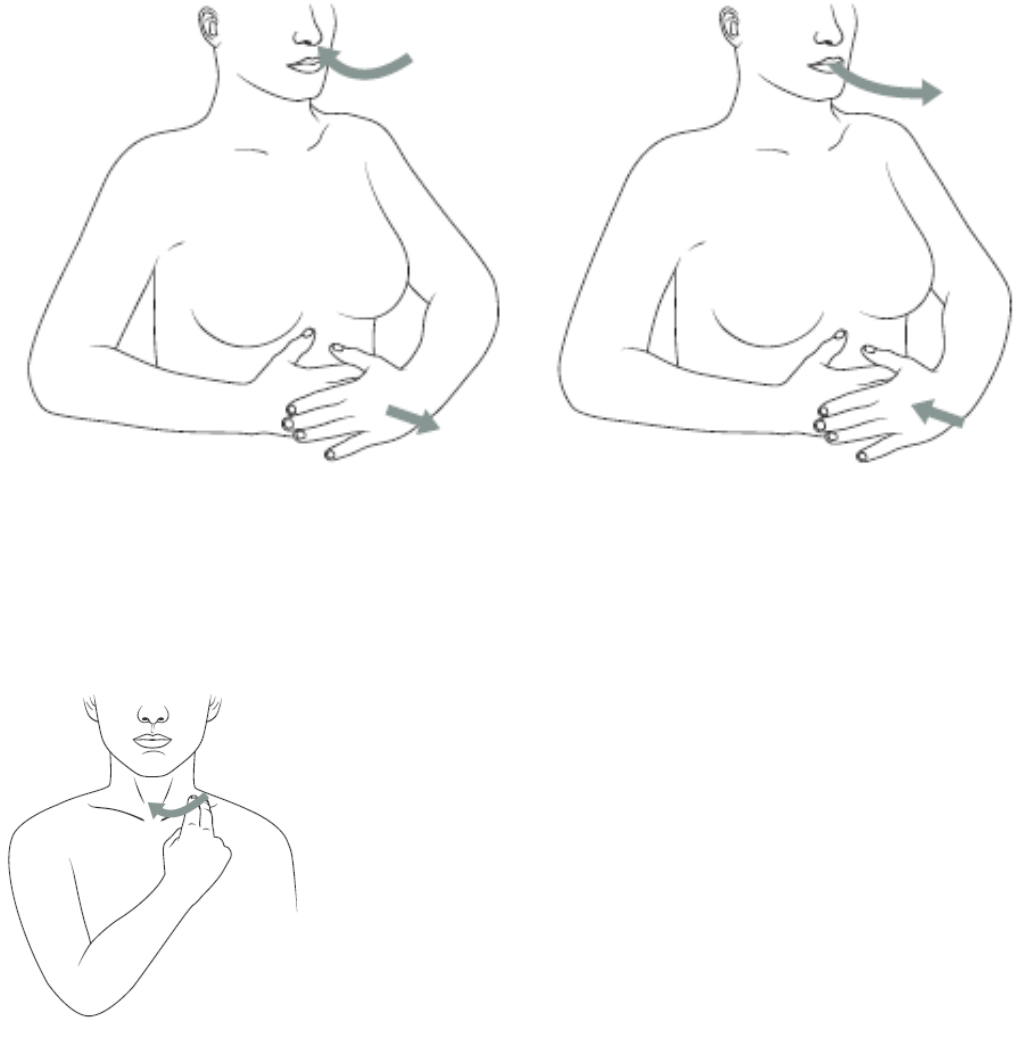
4
Page 4 of 9
1. Stimulate your lymphatic system with deep breathing
A very important part of your self-care is deep breathing. Deep breathing helps to
stimulate lymphatic system in your whole body. You can practice deep breathing
anytime!
• Place the palms/flats of your hands on your stomach
• Slowly, breathe in deeply through your nose, and let your stomach expand
• Breathe out slowly through pursed lips, and let your stomach flatten
• Repeat 5 times. Take a short rest between each breath so you do not get dizzy
2. Prepare your lymph nodes BEFORE Massage
This step prepares the lymph nodes that sit just above your collarbone and your
underarm to take in lymph fluid from your face and neck during massage.
• Place the flats of your 2nd and 3rd fingers on either side
of your neck, just above your collarbone. Do a shoulder
shrug up and feel the dip in the skin. This is the correct
position.
• Massage down and inwards towards your collarbone.
Always keep your fingers above your collarbone. Gently
stretch the skin just as far as it naturally goes and release.
• This massage will look like two “J” strokes facing one
another.
• Repeat 15 times.
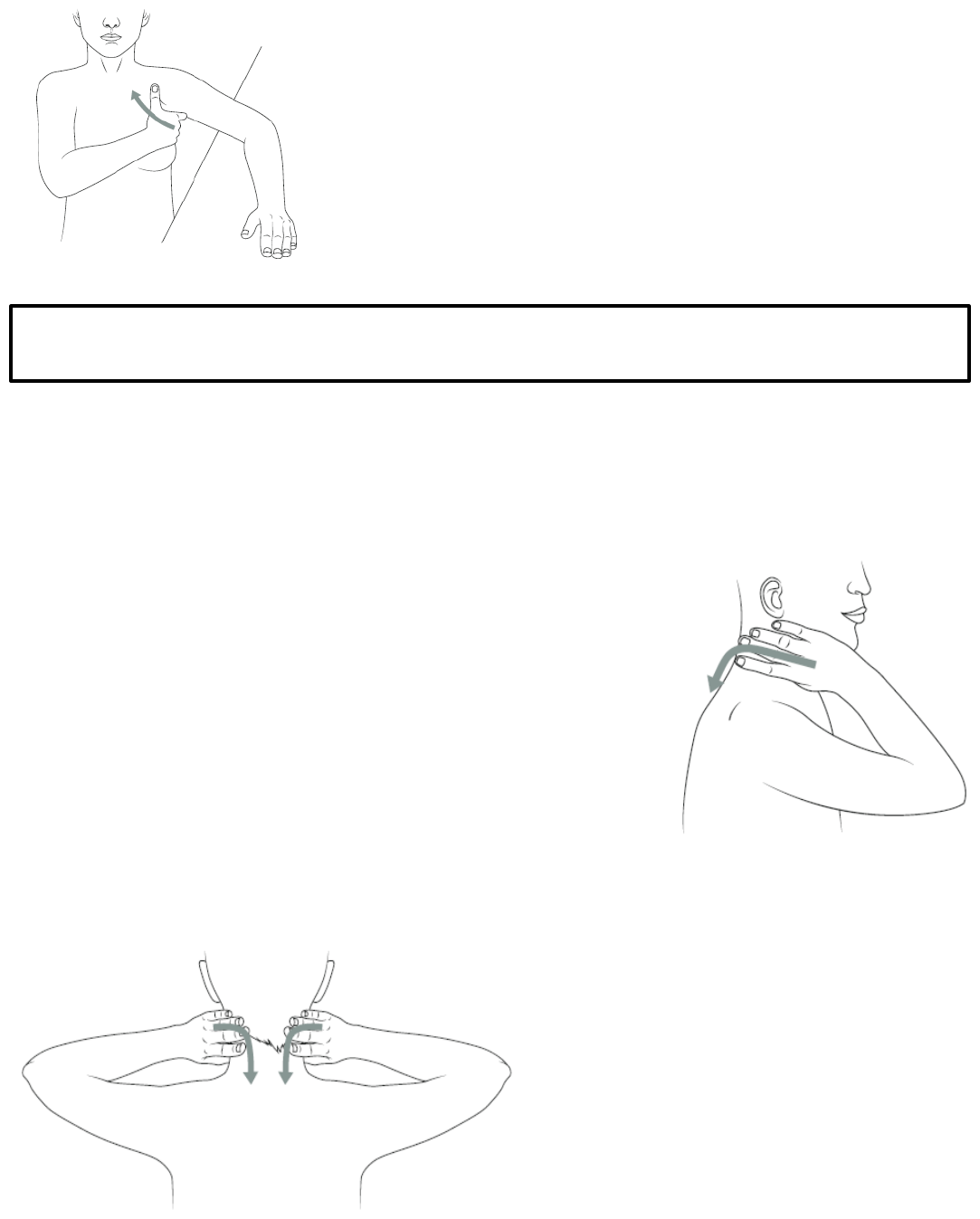
5
Page 5 of 9
You can massage one side at a time or both sides at the same time. Cross your
hands if you are doing both at the same time.
Place your arm in a comfortable position slightly elevated
and supported. If needed, try placing your arm on an
armrest or table for comfort.
• Place your palm against your underarm
• Gently pull up and in towards your body, then release
• Repeat 10 to 15 times.
• Repeat this action on your other underarm
3. Stretch and release the skin at the side of your neck
You can massage one side at a time, or do both sides together.
• Place your flat hands on either side of your neck,
just under your ears
• Gently stretch the skin back (away from your face)
and down, then release
• Try to massage your neck in a slow, gentle way,
following a rhythm
• Repeat 10 to 15 times
Remember: Keep your pressure light.
4. Stretch and release the skin on the back of your neck
• Place your flat hands on the back of
your neck, just below your hairline
on either side of your spine
• Stretch the skin towards your spine
and then down towards the base of
your neck and release
• Repeat 10 - 15 times
Tip: This can also be done using a soft ball, rolled up flannel or hand towel and
pumping your arm against your chest wall.
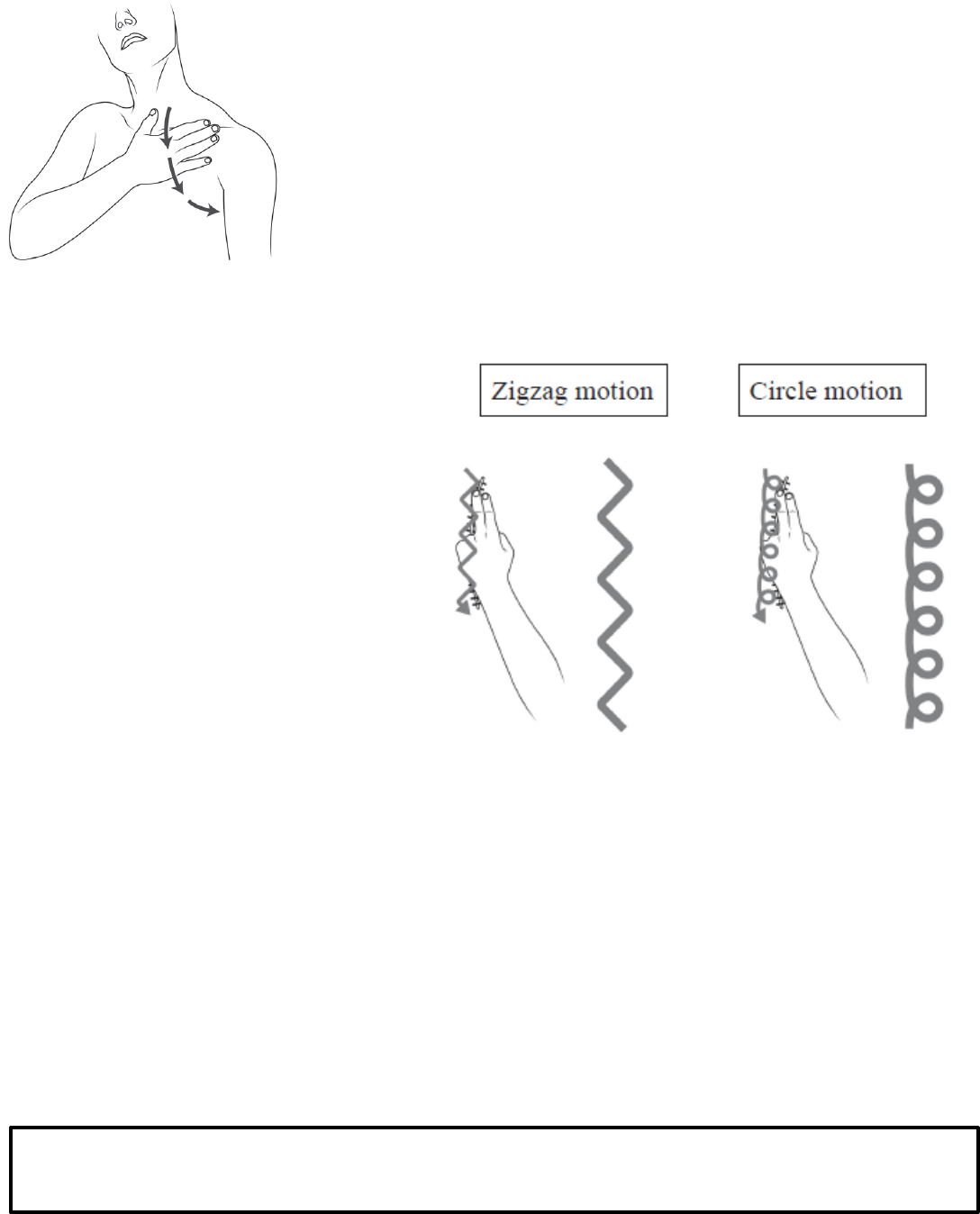
6
Page 6 of 9
5. Stretch and release the skin from your upper chest downwards
away from the head and neck
• Place you hand on your collarbone. Move your hand
down toward your underarm. This massage will move
the lymph fluid from your neck and chest to your
underarm lymph nodes.
• Gently stretch the skin (not muscles) down your chest
and towards your underarm. Then let go of the skin.
• Repeat this massage 10 - 15 times.
6. Massage your scar
Massage your scar. This massage is
only if you have had surgery. Do not
massage until three weeks after
surgery. Do not massage until all
staples and clips have been removed.
Your scar may feel very sensitive,
tight or itchy. Scar massage will help
reduce these feelings.
This massage helps soften the scar
and allows better blood flow to the
area. You should not experience pain
when massaging your scar.
• Place the palm of your hand over the scar
• Move up and down in a zigzag pattern or circle pattern along the scar (as above)
• Apply firm but gentle pressure whilst moving along the scar - try to move the skin, if
possible lift the skin along the scar
• Repeat 5 times along the scar
• Now place your fingertips just above the scar and gently strech the skin away from
the scar and release. Repeat this action 5 times.
• Place your fingertips below the scar, gently stretching the skin away from the scar,
and releasing. Repeat 5 times.
Tip: Do not use oil while doing the scar massage. Apply any lotions or oils after the
massage.

7
Page 7 of 9
7. Massage for face swelling
• Stroke above and below your lips finishing in front of
your ears where your side burns are
• Stroke from bridge of nose outwards across your cheeks
finishing in front of your ears. Start at the tip of your
nose.
• As above working upwards towards your eyes, being
careful not to press too hard around the eye area
• Lightly pinch the eyebrows, starting from the inner brow
moving outwards to the outer eyebrows to facilitate
lymphatic drainage towards the peri-auricular lymph
nodes in front of your ears
Peri-auricular lymph nodes

8
Page 8 of 9
• Stretch the skin from the outer forehead, working down to
your side burns.
8. Massage for swelling inside the mouth
9. Massage for the back of the head
Gently stretch the skin from the outer back of the head down towards the neck.
Follow the numbered diagram above starting at number 1. Then continue to
stretch the skin at the level of number 2, then 3 (see next page).
Tip: Do not massage inside your mouth if you have got any sores, cuts or
pains.
Ensure hands are clean.
You can use an electric toothbrush to assist in massaging the inside of your
mouth but remember to keep the pressure light.
A good exercise for assisting in facial swelling is to try and stretch your mouth
open wide. You can do this whilst pronouncing “A, E, I, O, U”.
Do not stretch your mouth wide open if it is painful.
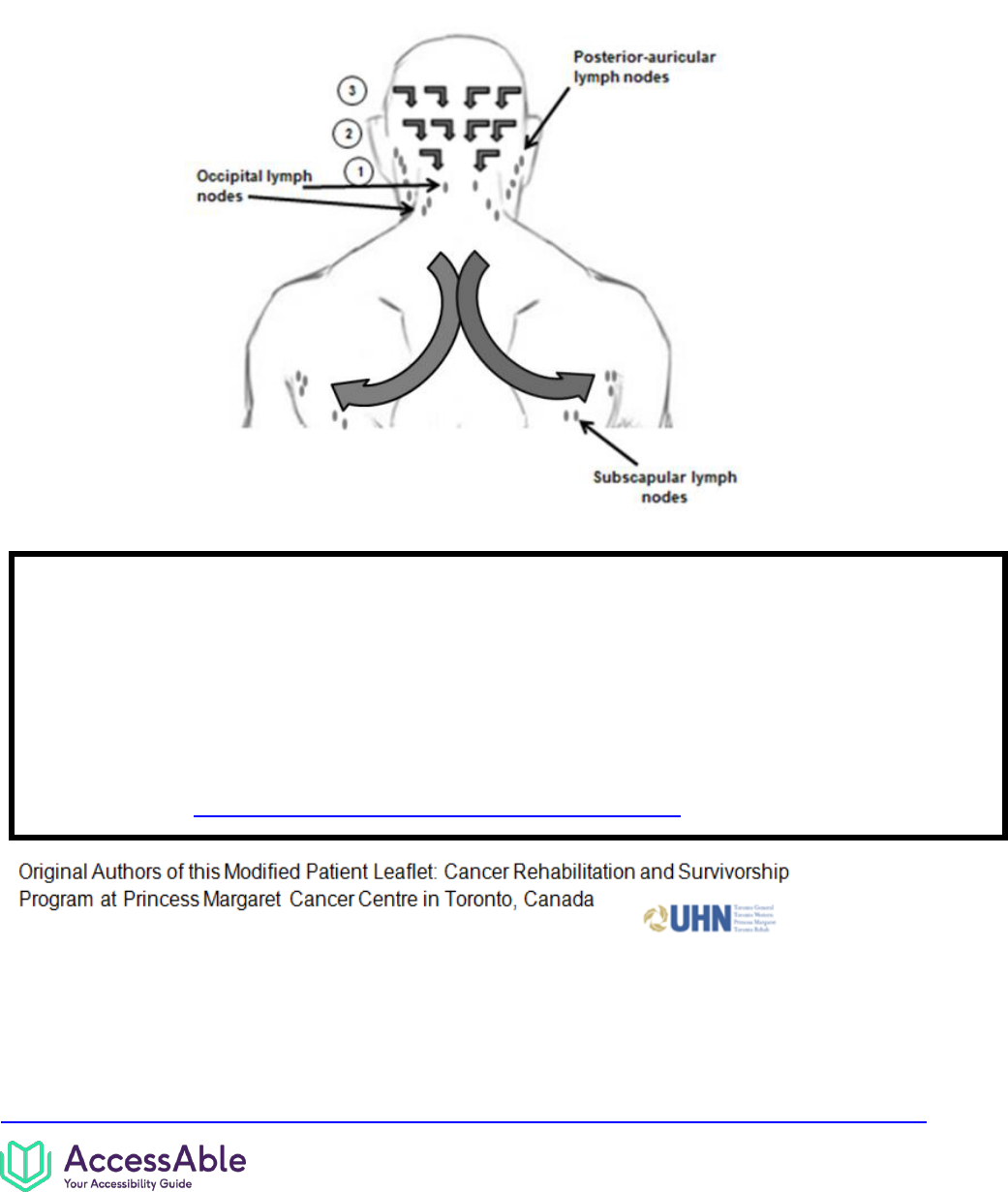
9
Page 9 of 9
Repeat each row x3 then stroke down to armpit across the central shoulder blades,
following the large arrows above.
If you would like any information regarding access to the West Suffolk Hospital and its
facilities please visit the website for AccessAble (the new name for DisabledGo)
https://www.accessable.co.uk/organisations/west-suffolk-nhs-foundation-trust
© West Suffolk NHS Foundation Trust
Contact information
If you have questions about self-lymphatic massage, please contact the
Lymphoedema Clinic:
Telephone: Landline: 01284 712732 – the answerphone is monitored
regularly so please leave a message if there is no answer
E-mail: wsh-tr.wslymphoedemaserv[email protected]
